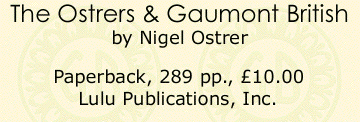



Review by Malcolm Baird
The name "Gaumont British" is well known to film historians but it means nothing to the average person under the age of 70. However, in the 1930s Gaumont British (GB) dominated the British film industry with its large chain of cinemas and its vast studio complex at Lime Grove. GB enployed people of the calibre of Alfred Hitchcock, Rex Harrison and Margaret Lockwood. The person who "made it all possible" was a quiet-spoken and somewhat reclusive individual called Isidore Ostrer. Born in 1889 to a humble Jewish family in Whitechapel, he had made his first fortune in textiles during World War 1, then he established a private bank , and in 1922 he took over the Gaumont film company from its French founders and renamed it Gaumont British. After a few years, talking pictures arrived and GB moved into its decade of glory, the 1930s.
Nigel Ostrer is a nephew of the famous Isidore; his father Maurice was one of the five brothers most of whom had film connections, but Isidore was the dominant figure in the clan. This new book is a welcome change from the usual run of film history books which tend to be either memories of the stars (strong on film stills but weak on text) or statistical compilations featuring bar charts. The first part of the book (Chapters 1-11) is on Isidore and the various Ostrer relatives. All too often family histories can be unreadable, but Nigel Ostrer's book is a refreshing exception. He evokes the various personalities in a coloquial style, laced with hilarious anecdotes and the occasional expletive.
The second part of the book (Chapters 12-24) sets out the history of Gaumont British. It owed its success not only to the astuteness of Ostrer but also to historical timing: the film industry was immensely boosted by the arrival of talkies in 1929, and cinema attendance also rose because of audiences' need for mental escape from the bad economic times and the growing troubles in Europe.
Early in 1932, GB quietly took over Baird Television Ltd. which had become financially precarious. As a result, Baird Television received a badly-needed infusion of capital which enabled it to hire some brilliant scientists with expertise in the new technology of electronic television, and to move to the Crystal Palace where a fully equiped television studio and ultra short wave transmitter was set up. After a boardroom coup in 1933 my father's position as managing director became nominal, although he was still well paid. Under the new arrangement he was relieved of administrative duties and this freed him to do full time research on large-screen and colour television. Ostrer felt that television could be part of his film empire, with live telecasts of sporting events being shown on cinema screens as an accompaniment to the main feature film. He and my father both felt that the BBC was acting as a dog-in-a-manger on television. They lacked the resources and the will to support it properly, but they were jealous of their legislated monopoly over broadcasting.
At the outbreak of World War 11, all television was shut down. GB came under scrutiny by a Board of Trade enquiry and Ostrer also felt threatened by the possibility of German invasion. In 1940 he was named on the infamous Nazi death list of people they thought to be a danger, including Winston Churchill, J.B.Priestly and Noel Coward. In 1941 GB was sold to rival film magnate J.Arthur Rank; all Gaumont cinemas were rebranded as Odeon cinemas. Ostrer moved to the USA for the war years and though he eventually returned to Britain he never made a major comeback in the film industry. His business interest returned to the textile industry in which he had started many years earlier. He lived on until 1975 in semi-seclusion.
On a technical note, this book is strongly commended for its readable type size and for the setting and captioning of the photographs. Under the guidance of Nigel Ostrer, the publishers have refrained from the modern tendency to miniaturise the photographs to almost postage-stamp size. The only negative comment concerns the lack of an index which could have helped the reader to navigate through the many names of the Ostrer clan and the others who were part of this fascinating story.
March 12 2010
www.bairdtelevision.com